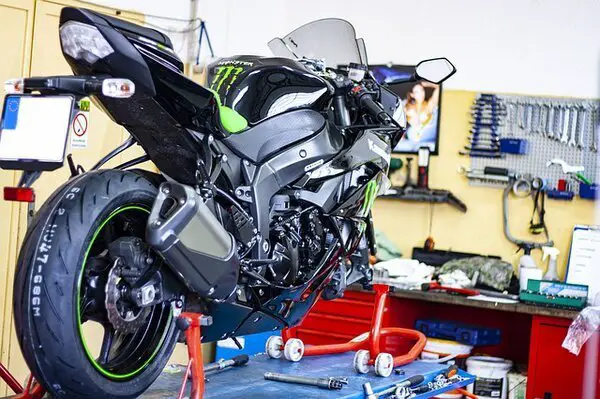Have you ever noticed your motorcycle brakes feel spongy and lose all their pressure? This is when you have to pressurize them properly. It happens in most cases when you have recently changed your brake fluid. You will have to properly bleed your brakes and then pump them up to pressurize them. You can use either gravity bleed, or vacuum bleeds your brakes to do that. So, how do you pressurize motorcycle brakes?
We are going to discuss all these matters in this article.
Let’s get started.
Why Do My Brakes Feel Squishy and Soft?
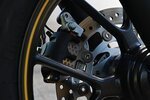
Your motorcycle brakes are feeling loose for some reason? You might have to pressurize them, but how to do that? First, let us have a look at what the purpose of brake fluid is.
When you apply pressure to fluid, it transmits that pressure equally in all directions. This is a postulation that Blaise Pascal, a scientist, and mathematician, presented back in the 17th Century. It later became a scientific law.
Now, if you have hydraulic brakes, when you squeeze the level or stomp the pedal, the link connected to that master cylinder piston puts force on the brake fluid. As a result, pressure expands in all directions and moves all the moveable items, like the caliper piston.
With this expansion, pressure shoves those pads up against your rotors and drags you to a halt. Bleeding your brakes is important because air is compressible, as it is a gas. Now, if there is air in your lines, it will compress, and your pedal or lever will move.
But it will not budge the piston. The result will be squishy, soft brakes, that is, any braking power left. With the help of bleeding, you can get all that air out and seal your braking system properly.
How To Pressurize My Bike Brakes?
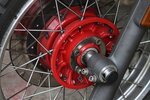
Noticing your brakes feeling soft and squishy? Well, you have to pressurize them properly to get all that air out. But how can you do that? Achieving that pressure again is pretty straightforward.
You will have to bleed your brakes and get that pressure back. But what if you have already done it? Well, you have to redo it because air might not have chased out of the system properly the first time.
If you have done it before, bleeding is quite a simple process. So doing it again will not be a problem for you. However, if you have fluid, you must pump the brakes up to achieve the pressure. The next step is to open your bleeder without releasing your brakes. It will expel all the air.
Now close the bleeder and let the brake lever or pedal come back to its normal resting position. You will have to keep doing this until you get that pressurized feeling.
There, it is as simple as that! You will have to go through this process about 3 or 4 times to get all the air out. As a result, your motorcycle brakes will be as good as new ones. So, there is a simple answer to your question, “how do you pressurize motorcycle brakes.”
Some Critical Tips to Keep In Mind
People get nervous about this matter, and they should, frankly, because it is about brakes. Bad brakes are not a good thing as you are jeopardizing your safety. Here are some tips and tricks that you need to follow when solving “how do you pressurize your motorcycle brakes.”
Cover your bike up
Brake fluid is not friendly to your paint. Therefore, if you value those shiny parts of your bike, you have to cover them before beginning the bleeding process. You might not have to do this unless you want to go for new paint.
If you fail to cover your bike up, your small DIY project here to save some money can end up in a heart-crushing catastrophe. You do not want that brake fluid anywhere near these shiny bits or your paint on the bike. Hence, you need to shield everything you can to keep it safe during the bleeding process.
Zip-tying brake lever to handlebars

If you happen to visit a motocross event, you will see many folks have zip-tied their brake levers to their handlebars. It is to make sure the brakes are at their firmest. You can chuck a brick on the brake pedal or zip-tie it down as hard as you can.
You can wrap a rag here to prevent any damage. Keep it this way overnight and cut that zip-tie the following day. You will notice that zip-tying overnight makes your brakes feel firm again.
But why does this work? According to some people, with pressure, the air is driven to the upper column. But with pressure for an extended time, the open purge port allows air bubbles to gather in one spot and eventually pop out.
Furthermore, it stretches out some rubber components in your brake system. If you have a brake system that is very hard to bleed, then zip-tying will work like a charm.
Be careful when putting the master reservoir back on top
When you put the top back on your master reservoir, you will not have to screw it tightly down. Give it a couple of turns. With the turn, you are building pressure, and it can cause geysers.
If you have covered your bike up, then these geysers will not be a problem for you. But, if not, then these geysers can splash brake fluid on your paint. So, keep your bike covered during the entire process.
Bleed from the farthest port from your master cylinder
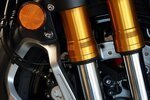
You can check the owner manual of your bike, and it will guide you about the specific order to do these things. But if nothing is mentioned there, start from the farthest item from your master cylinder.
If you have dual-disc front brakes, then usually, it means that you will have to begin with the front caliper on the left. However, technically you can do this in whatever order you like. But if there is loads of air in your brake lines, it will drive most air out of the system.
Usually, this is the case when you have recently installed new stainless steel braided brake lines. The method works well as it will make you pump less.
After that, you can move to the next caliper and then to your bleed port located at the master cylinder if you have your bike equipped. With the bleeder port upon the master, every trace of hard to bleed air will get out of the lines.
Prevent any leaks in your braking system
Your brakes are a sealed system. Therefore, if you are losing any of your brake fluid regularly, then there is something wrong. Simple bleeding is not going to work here.
Likewise, as the fluid level drops with wearing pads, do not just add more fluid hastily. As a result, you will push the fluid out from the reservoir on your next brake repair as you drive your caliper piston back in its bore.
Keep your master full
You have to make sure that you keep your master full. Otherwise, air will get into your fluid with each brake pumping. You will have to start from zero again, so avoid this hassle by keeping your master cylinder reservoir full.
Choose the correct brake fluid
Brake fluids are available in a range of different types. Some of these brake fluids are castor oil-based, and some are made of glycol. Some of these brake fluids are derived from silicone too.
But you have to keep in mind that none of these bases work well together. So, therefore, you have to make sure that you are putting the fluid in with the correct formulation, along with the appropriate boiling point.
Some will mix and blend well, while others do not. For instance, you can replace DOT 3 with DOT 4, but you cannot do the opposite. Moreover, DOT 5 and 5.1 might sound similar, but you cannot mix them.
Doing an extended bleed
Extended bleeding will always work. Therefore, bell out as much fluid as possible from your master cylinder reservoir, but do not go dry. You need to refill it and then do it again a couple of times.
It is easy because your master cylinder reservoir does not go dry. Therefore, you do not have to be bothered about what to do if you are not getting any pressure when you are starting.
Gravity bleed when you are not getting pressure
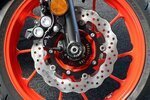
You will have to fill your master cylinder reservoir, crack your bleeders, and wait for the fluid to appear at those bleeders. You are using gravity to draw the fluid through your braking system.
Using gravity to bleed will get you enough pressure to complete your job in a normal fashion. However, gravity bleeding will only work if your caliper is lower than your master cylinder reservoir.
Another method to bleed your brakes is the pressure tank method. It is the most effective way to bleed your brakes as it will get all the air and contaminated brake fluid out of your system.
But you will need to have the pressure tank with you in your garage to use this method. Yet another method you can go for is vacuum bleeding to complete your job. But vacuum bleeding is not that effective, and experts do not recommend it. Therefore, your best option is to go for gravity bleeding.
FAQs
Why do I keep getting air in my brake lines?
If there is excessive water in the system, when your brake fluid boils, it will cause steam. Your braking system compresses this steam and turns it into water. When air separates from the water, you will have a large pocket of air in your brake lines.
Apart from that, air pockets can also develop during your last brake job, and you have to bleed your brakes to get it out or lose the pressure.
What is the best method to bleed your brakes?
So how do you pressurize motorcycle brakes? It is simple, as you have to bleed your brakes to get all the air out and get that pressure back. A straightforward method to do this is gravity bleed. You will have to open your bleed valve and expel your brake fluid using gravity.
Fill the system with more fluid and then close the bleed valve. You can use pressure or vacuum for bleeding your brakes too. The simplest method is to go for gravity bleeding, while the most effective is pressure bleeding. The experts do not recommend vacuum bleeding.
Should I bleed my brakes with the cap on or off?
The cap on your master cylinder reservoir should be off when you are bleeding your brakes. You also have to follow the correct sequence of bleeding. It is better that you take guidance from your motorcycle manual. If it does not say anything about bleeding brakes, you must start with the front caliper on the left.
Is bleeding brakes a one-person job, or do I need an extra pair of hands?
If you do not have anyone to help you, you should go with the gravity bleeding method. It is the most straightforward one-person job for brake bleeding. You will only have to attach the hose to your bleed screw and open it up.
Now, wait and watch the old brake fluid, along with the air, come out of your lines. Finally, close the bleed screw, and fill the master cylinder reservoir with more brake fluid when done.
Does gravity bleeding take a long time?
Gravity bleeding is a straightforward process if you solve the problem of “how do you pressurize motorcycle brakes”. But the simple methods do take some time because you are using gravity to draw the fluid out.
This fluid is not watery, so it has a slow flow. Generally, it will take you around half an hour if the fluid is timeworn. It is because contaminants within make the fluid thicker and reduce its flow further.
Conclusion
There you have it. Now you know how do you pressurize motorcycle brakes.
The best way to get that pressure back is to bleed your brakes. There are different methods to do that, but gravity bleeding is the simplest thing you can do in your garage.
But make sure that you cover your bike up because you do not want that brake fluid to be anywhere near the paint or those shiny bits on your bike.

